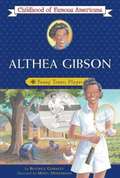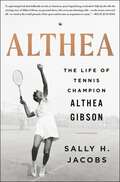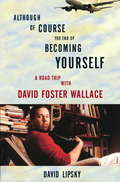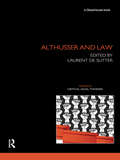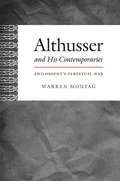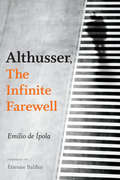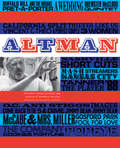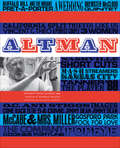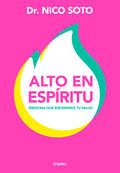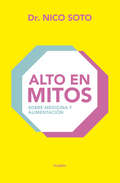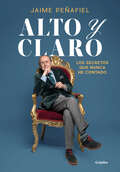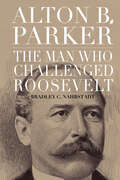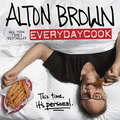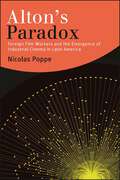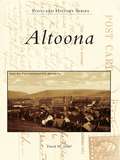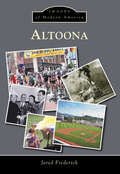- Table View
- List View
Althea Gibson, the Tiger of Tennis (Fountas & Pinnell Classroom, Guided Reading)
by Alice Cary Jani OrbanNIMAC-sourced textbook. Changing the Face of Tennis. Althea Gibson spent her childhood getting into trouble on the streets of Harlem, New York. She grew up to change the world of championship tennis forever.
Althea Gibson: Young Tennis Player (Childhood of Famous Americans Series)
by Beatrice GormleyAlthea Gibson (1927-2003) was the first black tennis player ever to compete in the U.S. Open and at Wimbledon in England. This fictionalized biography focuses on Gibson's spirited childhood and highlights the traits that later made her a champion.
Althea: The Life of Tennis Champion Althea Gibson
by Sally H. Jacobs“A captivating book that brilliantly reveals an American sports legend long overlooked. Sally Jacobs tells the riveting story of Althea Gibson, my personal shero, who overcame daunting odds – on the tennis court and off - to stand at the world pinnacle of her sport and became an inspiration to many.” — Billie Jean KingIn 1950, three years after Jackie Robinson first walked onto the diamond at Ebbets Field, the all-white, upper-crust US Lawn Tennis Association opened its door just a crack to receive a powerhouse player who would integrate "the game of royalty." The player was a street-savvy young Black woman from Harlem named Althea Gibson who was about as out-of-place in that rarefied and intolerant world as any aspiring tennis champion could be. Her tattered jeans and short-cropped hair drew stares from everyone who watched her play, but her astonishing performance on the court soon eclipsed the negative feelings being cast her way as she eventually became one of the greatest American tennis champions.Gibson had a stunning career. Raised in New York and trained by a pair of tennis-playing doctors in the South, Gibson’s immense talent on the court opened the door for her to compete around the world. She won top prizes at Wimbledon and Forest Hills time and time again. The young woman underestimated by so many wound up shaking hands with Queen Elizabeth II, being driven up Broadway in a snowstorm of ticker tape, and ultimately became the first Black woman to appear on the cover of Sports Illustrated and the second to appear on the cover of Time. In a crowning achievement, Althea Gibson became the No. One ranked female tennis player in the world for both 1957 and 1958. Seven years later she broke the color barrier again where she became the first Black woman to join the Ladies Professional Golf Association (LPGA). In Althea, prize-winning former Boston Globe reporter Sally H. Jacobs tells the heart-rending story of this pioneer, a remarkable woman who was a trailblazer, a champion, and one of the most remarkable Americans of the twentieth century.
Although Of Course You End Up Becoming Yourself: A Road Trip with David Foster Wallace
by David LipskySOON TO BE A MAJOR MOTION PICTURE, STARRING JASON SEGAL AND JESSE EISENBERG, DIRECTED BY JAMES PONSOLDTAn indelible portrait of David Foster Wallace, by turns funny and inspiring, based on a five-day trip with award-winning writer David Lipsky during Wallace's Infinite Jest tour In David Lipsky's view, David Foster Wallace was the best young writer in America. Wallace's pieces for Harper's magazine in the '90s were, according to Lipsky, "like hearing for the first time the brain voice of everybody I knew: Here was how we all talked, experienced, thought. It was like smelling the damp in the air, seeing the first flash from a storm a mile away. You knew something gigantic was coming."Then Rolling Stone sent Lipsky to join Wallace on the last leg of his book tour for Infinite Jest, the novel that made him internationally famous. They lose to each other at chess. They get iced-in at an airport. They dash to Chicago to catch a make-up flight. They endure a terrible reader's escort in Minneapolis. Wallace does a reading, a signing, an NPR appearance. Wallace gives in and imbibes titanic amounts of hotel television (what he calls an "orgy of spectation"). They fly back to Illinois, drive home, walk Wallace's dogs. Amid these everyday events, Wallace tells Lipsky remarkable things--everything he can about his life, how he feels, what he thinks, what terrifies and fascinates and confounds him--in the writing voice Lipsky had come to love. Lipsky took notes, stopped envying him, and came to feel about him--that grateful, awake feeling--the same way he felt about Infinite Jest. Then Lipsky heads to the airport, and Wallace goes to a dance at a Baptist church.A biography in five days, Although Of Course You End Up Becoming Yourself is David Foster Wallace as few experienced this great American writer. Told in his own words, here is Wallace's own story, and his astonishing, humane, alert way of looking at the world; here are stories of being a young writer--of being young generally--trying to knit together your ideas of who you should be and who other people expect you to be, and of being young in March of 1996. And of what it was like to be with and--as he tells it--what it was like to become David Foster Wallace."If you can think of times in your life that you've treated people with extraordinary decency and love, and pure uninterested concern, just because they were valuable as human beings. The ability to do that with ourselves. To treat ourselves the way we would treat a really good, precious friend. Or a tiny child of ours that we absolutely loved more than life itself. And I think it's probably possible to achieve that. I think part of the job we're here for is to learn how to do it. I know that sounds a little pious."--David Foster Wallace From the Trade Paperback edition.Lambert Fellowship, a Media Award from GLAAD, and a National Magazine Award. He's the author of the novel The Art Fair, a collection of stories, Three Thousand Dollars, and the bestselling nonfiction book Absolutely American, which was a Time magazine Best Book of the Year. From the Trade Paperback edition.
Althusser and Law (Nomikoi: Critical Legal Thinkers)
by Laurent De SutterAlthusser and Law is the first book specifically dedicated to the place of law in Louis Althusser’s philosophy. The growing importance of Althusser’s philosophy in contemporary debates on the left has - for practical and political, as well theoretical reasons - made a sustained consideration of his conception of law more necessary than ever. As a form of what Althusser called ‘Ideological State Apparatuses’, law is at the forefront of political struggles: from the destruction of Labour Law to the exploitation of Patent Law; from the privatisation of Public Law to the ongoing hegemony of Commercial Law; and from the discourse on Human Rights to the practice of judicial courts. Is Althusser still useful in helping us to understand these struggles? Does he have something to teach us about how law is produced, and how it is used and misused? This collection demonstrates that Althusser’s ideas about law are more important, and more contemporary, than ever. Indeed, the contributors to Althusser and Law argue that Althusser offers a new and invaluable perspective on the place of law in contemporary life.
Althusser and Pasolini: Philosophy, Marxism, and Film
by Agon HamzaAgon Hamza offers an in-depth analysis of the main thesis of Louis Althusser's philosophical enterprise alongside a clear, engaging dissection of Pier Paolo Pasolini's most important films. There is a philosophical, religious, and political relationship between Althusser's philosophy and Pier Paolo Pasolini's films. Hamza teases out the points of contact, placing specific focus on critiques of ideology, religion, ideological state apparatuses, and the class struggle. The discussion, however, does not address Althusser and Pasolini alone. Hamza also draws on Spinoza, Hegel, Marx, and Žižek to complete his study. Pasolini's films are a treasure-trove of Althusserian thought, and Hamza ably employs Althusserian terms in his reading of the films. Althusser and Pasolini provides a creative reconstruction of Althusserian philosophy, as well as a novel examination of Pasolini's film from the perspective of the filmmaker's own thought and Althusser's theses.
Althusser and his Contemporaries: Philosophy's Perpetual War
by Warren MontagAlthusser and His Contemporaries alters and expands understanding of Louis Althusser and French philosophy of the 1960s and 1970s. Thousands of pages of previously unpublished work from different periods of Althusser's career have been made available in French since his death in 1990. Based on meticulous study of the philosopher's posthumous publications, as well as his unpublished manuscripts, lecture notes, letters, and marginalia, Warren Montag provides a thoroughgoing reevaluation of Althusser's philosophical project. Montag shows that the theorist was intensely engaged with the work of his contemporaries, particularly Foucault, Derrida, Deleuze, and Lacan. Examining Althusser's philosophy as a series of encounters with his peers' thought, Montag contends that Althusser's major philosophical confrontations revolved around three themes: structure, subject, and beginnings and endings. Reading Althusser reading his contemporaries, Montag sheds new light on structuralism, poststructuralism, and the extraordinary moment of French thought in the 1960s and 1970s.
Althusser, The Infinite Farewell
by Étienne Balibar Emilio De Ípola Gavin ArnallIn Althusser, The Infinite Farewell—originally published in Spanish and appearing here in English for the first time—Emilio de Ípola contends that Althusser’s oeuvre is divided between two fundamentally different and at times contradictory projects. The first is the familiar Althusser, that of For Marx and Reading Capital. Symptomatically reading these canonical texts alongside Althusser’s lesser-known writings, de Ípola reveals a second, subterranean current of thought that flows throughout Althusser’s classic formulations and which only gains explicit expression in his later works. This subterranean current leads Althusser to move toward an aleatory materialism, or a materialism of the encounter. By explicating this key aspect of Althusser’s theoretical practice, de Ípola revitalizes classic debates concerning major theoretico-political topics, including the relationship between Marxism, structuralism, and psychoanalysis; the difference between ideology, philosophy, and science; and the role of contingency and subjectivity in political encounters and social transformation. In so doing, he underscores Althusser’s continuing importance to political theory and Marxist and post-Marxist thought.
Altius Golf and the Fighter Brand
by Robert J. Dolan Sunru YongAltius Golf is the clear leader in the golf ball market despite a long-term decline in the number of golfers and a drop in sales following the financial crisis. The firm has maintained its position by introducing generations of advanced, super-premium golf balls that allow their customers to emulate professional golfers. The company has been losing market share to lower-priced competitors and the CEO wants to introduce a new program called Elevate to foster the next generation of golfers. With Elevate, the firm will introduce a ball that is more forgiving and easier to drive for distance and offer it at a price 40% below the company's flagship brand. Elevate will be available through "off-course" channels such as golf specialty stores and big box retailers instead of "on-course" pro shops where the firm typically sells its products. The board of directors is divided on whether to support the decision. Students must perform a quantitative analysis of the CEO's proposal to understand the potential risks and gains before making a final recommendation.
Altman
by Kathryn Reed Altman Giulia D'Agnolo VallanFor decades, Robert Altman fascinated audiences with pioneering films—among them M*A*S*H, Nashville, The Player, and Gosford Park—that combined technical innovation with subversive, satirical humor and impassioned political engagement. His ability to explore and engage so many different worlds with a single, coherent vision changed the landscape of cinema forever. This signature "Altmanesque" style is, in the words of Martin Scorsese: "as recognizable and familiar as Renoir's brushstrokes or Debussy's orchestrations." Now, the Altman estate opens its archive to celebrate his extraordinary life and career in the first authorized visual biography on the iconoclastic director. Altman, by Altman’s widow Kathryn Reed Altman and film critic Giulia D’Agnolo Vallan, brims with photographs and ephemera, many culled from private family albums, and personal recollections of the director. Alongside the intimate illustrated story is a complete visual, historical, and critical narrative of Altman’s films and his process. To honor the Altman trademark of using a wide cast of characters, Altman also features contributions from his collaborators and contemporaries including Frank Barhydt, E. L. Doctorow, Roger Ebert, Jules Feiffer, Julian Fellowes, James Franco, Tess Gallagher, Pauline Kael, Garrison Keillor, Michael Murphy, Martin Scorsese, Lily Tomlin, Alan Rudolph, Michael Tolkin, and Kurt Vonnegut Jr.
Altman (Text-Only Edition)
by Kathryn Reed AltmanFor decades, Robert Altman fascinated audiences with pioneering films—among them M*A*S*H, Nashville, The Player, and Gosford Park—that combined technical innovation with subversive, satirical humor and impassioned political engagement. His ability to explore and engage so many different worlds with a single, coherent vision changed the landscape of cinema forever. This signature "Altmanesque" style is, in the words of Martin Scorsese: "as recognizable and familiar as Renoir's brushstrokes or Debussy's orchestrations." Now, the Altman estate opens its archive to celebrate his extraordinary life and career in the first authorized visual biography on the iconoclastic director. Altman, by Altman’s widow Kathryn Reed Altman and film critic Giulia D’Agnolo Vallan, brims with photographs and ephemera, many culled from private family albums, and personal recollections of the director. Alongside the intimate illustrated story is a complete visual, historical, and critical narrative of Altman’s films and his process. To honor the Altman trademark of using a wide cast of characters, Altman also features contributions from his collaborators and contemporaries including Frank Barhydt, E. L. Doctorow, Roger Ebert, Jules Feiffer, Julian Fellowes, James Franco, Tess Gallagher, Pauline Kael, Garrison Keillor, Michael Murphy, Martin Scorsese, Lily Tomlin, Alan Rudolph, Michael Tolkin, and Kurt Vonnegut Jr.
Altmetrics for Research Outputs Measurement and Scholarly Information Management: International Altmetrics Workshop, AROSIM 2018, Singapore, Singapore, January 26, 2018, Revised Selected Papers (Communications in Computer and Information Science #856)
by Mojisola Erdt Aravind Sesagiri Raamkumar Edie Rasmussen Yin-Leng ThengThis book constitutes the refereed proceedings of the International Workshop on Altmetrics for Research Outputs Measurements and Scholarly Information Management, AROSIM 2018, held in Singapore, in January 2018. The 7 revised full papers presented together with two keynote papers and one introduction paper were carefully reviewed and selected from 20 submissions. The workshop will investigate how social media based metrics along with traditional and non-traditional metrics can advance the state-of-the-art in measuring research outputs.
Alto en espíritu
by Dr. Nico SotoTercera entrega de la serie de libros de salud del querido y carismático doctor Nico Soto. Esta vez, nuestro doctor wachini mira las enfermedades desde una perspectiva integral, abarcando también el cuerpo espiritual. Medicina, ciencia y espíritu se encuentran en el tercer libro del doctor Nico Soto, en el que le habla a sus wachinis sobre cómo descomplejizar procesos médicos de una forma en la que nunca antes se había planteado la ciencia y la medicina. Ocupando su superpoder de la narración de distintos procesos, desmenuza los procesos médicos para que sus wachinis, como llama a los pacientes, puedan observar observar, analizar, digerir, integrar y transformar las enfermedades desde una perspectiva integrativa y antroposófica. Con mucho flow, el doctor más influencer de Chile nos habla de la biología y el espíritu en constante movimiento.
Alto en mitos: Sobre medicina y alimentación
by Dr. Nico SotoEn este libro, el doctor Nico Soto derribará todos los mitos que nos han impedido tener una vida más saludable. A todos nos han dicho cosas que supuestamente nos ayudarán a tener una vida más saludable. ¿Comer cada tres horas? ¿Dejar los carbohidratos? ¿Evitar la fruta porque tiene mucha azúcar? Estas son algunas de las cosas que creemos completamente ciertas y se han posicionado en nuestra sociedad como verdades inamovibles… pero ¡son mitos! El doctor Nicolás Soto nos hace un recorrido por todas estas creencias que por años nos han hecho comer cosas poco saludables, y así derribar los mitos de una vez por todas. Con ingenio y de forma lúdica, nos ayuda a tomar las riendas de nuestra salud y nunca más caer en las mentiras que se han masificado gracias a la influencia de industrias y corporaciones.
Alto en salud
by Dr. Nico SotoVuelve el Dr. Nico Soto con un nuevo libro que nos ayudará a seguir promoviendo nuestra salud. Luego del éxito de Alto en mitos, el Dr. Nico Soto vuelve con Alto en salud, un libro que te ayudará a entender las enfermedades más comunes y a romper todas las creencias que ya han sido desmentidas por estudios, pero que los diostores nos siguen repitiendo hasta el cansancio. Este segundo libro se centra en seguir derrumbando mitos en las enfermedades más comunes, como diabetes, colon irritable, depresión, acné, fibromialgia, hipertiroidismo, hipertensión, entre muchas otras. Todo con una perspectiva integrativa, donde tiene en cuenta nuestro cuerpo, nuestra mente y nuestra espiritualidad.
Alto y claro
by Jaime PeñafielRepaso de la vida personal y profesional de Jaime Peñafiel. Jaime Peñafiel, uno de los periodistas más reconocidos y veteranos de la profesión, siempre ha dicho que «valía más por lo que callaba que por lo que decía». Después de haber entrevistado a cientos de personalidades, de haber asistido a las fiestas, cócteles y recepciones más suntuosas en todo el mundo y ser testigo de excepción de las bodas más regias el avezado periodista rompe ahora su regla de oro para desvelar en Alto y claro algunos de los secretos que ha callado hasta hoy. Este libro forma parte de nuestra historia más reciente porque, a través de la pluma certera e incisiva de Jaime, conoceremos la trastienda de dictadores, reyes, reinas, princesas, duques, primeras damas, personajes del papel couché..., una trastienda donde, lejos de la mentira de los focos y las cámaras, descubrimos a hombres y mujeres de carne y hueso, cargados de deseos, esperanzas, pero también de frustraciones, miedos y, a veces, de mucha mucha soledad.
Altogether Gift: A Trinitarian Spirituality
by Michael DowneyThis poetic book on the Trinity offers reflections on the inter-personal dimensions of God and spells out the implications for spiritual life. While recent studies on the Trinity converge on the profoundly relational character of the mystery, less attention has been given to the way in which language of the Trinity speaks to the deepest desires of the human heart, the region of wound and wisdom wherein we long for loving communion with God and others. Michael Downey shows us that the doctrine of the Trinity is a grammar by which Christians speak of the ineffable mystery of God's constant, eternal giving as gift. By accepting this gift we participate in the divine life.
Alton B. Parker: The Man Who Challenged Roosevelt
by Bradley C. NahrstadtThis first full-length biography of Alton Brooks Parker provides an in-depth look into the life, career, and legacy of one of the most important New Yorkers of the Gilded Age. Parker had the courage to challenge Theodore Roosevelt for the presidency in 1904—at the height of Roosevelt’s popularity—and was a transition point between the conservative and the new, progressive wing of the Democratic Party. Based on new archival research, this book contributes to our understanding of how political campaigns were conducted during the Gilded Age/Progressive Era, in comparison to modern campaigns. It also provides insights into the changing Democratic Party as it transformed from the presidency of Grover Cleveland to the presidencies of Woodrow Wilson and Franklin D. Roosevelt.
Alton Brown: EveryDayCook
by Alton BrownMy name is Alton Brown, and I wrote this book. It's my first in a few years because I've been a little busy with TV stuff and interwebs stuff and live stage show stuff. Sure, I've been cooking, but it's been mostly to feed myself and people in my immediate vicinity--which is really what a cook is supposed to do, right? Well, one day I was sitting around trying to organize my recipes, and I realized that I should put them into a personal collection. One thing led to another, and here's EveryDayCook. There's still plenty of science and hopefully some humor in here (my agent says that's my "wheelhouse"), but unlike in my other books, a lot of attention went into the photos, which were all taken on my iPhone (take that, Instagram) and are suitable for framing. As for the recipes, which are arranged by time of day, they're pretty darned tasty. Highlights include: * Morning: Buttermilk Lassi, Overnight Coconut Oats, Nitrous Pancakes * Coffee Break: Cold Brew Coffee, Lacquered Bacon, Seedy Date Bars * Noon: Smoky the Meat Loaf, Grilled Cheese Grilled Sandwich, "EnchiLasagna" or "Lasagnalada" * Afternoon: Green Grape Cobbler, Crispy Chickpeas, Savory Greek Yogurt Dip * Evening: Bad Day Bitter Martini, Mussels-O-Miso, Garam Masalmon Steaks * Anytime: The General's Fried Chicken, Roasted Chile Salsa, Peach Punch Pops * Later: Cider House Fondue, Open Sesame Noodles, Chocapocalypse Cookie So let's review: 101 recipes with mouthwatering photos, a plethora of useful insights on methods, tools, and ingredients all written by an "award-winning and influential educator and tastemaker." That last part is from the PR office. Real people don't talk like that.From the Hardcover edition.
Alton's Paradox: Foreign Film Workers and the Emergence of Industrial Cinema in Latin America (SUNY series in Latin American Cinema)
by Nicolas PoppeAlton's Paradox builds upon extensive archival and primary research, but uses a single text as its point of departure—a 1934 article by the Hungarian American cinematographer John Alton in the Hollywood-published International Photographer. Writing from Argentina, Alton paradoxically argues of cine nacional, "The possibilities are enormous, but not until foreign technicians will take the matter in their hands and with foreign organization will there be local industry." Nicolas Poppe argues that Alton succinctly articulates a line of thought commonly held across Latin America during the early sound period but little explored by scholars: that foreign labor was pivotal to the rise of national film industries. In tracking this paradox from Hollywood to Mexico to Argentina and beyond, Poppe reconsiders a series of notions inextricably tied to traditional film historiography, including authorship, (dis)continuation, intermediality, labor, National Cinema, and transnationalism. Wide-angled views of national film industries complement close-up analyses of the work of José Mojica, Alex Phillips, Juan Orol, Ángel Mentasti, and Tito Davison.
Altoona
by Alex Payne Altoona Area Historical SocietyFounded in 1868, Altoona was once just a small town on the prairie--at least until the planes, trains, and automobiles came. Trains started crossing this town as planes made their way to the Altoona Airport, and the construction of Interstate 80 on Altoona's north edge brought many tourists. The growing community has become known across the state as the "Entertainment Capital of Iowa." Altoona is home to Adventureland Park, Iowa's largest amusement park, as well as Prairie Meadows Racetrack and Casino, and it hosted the state's first municipal airport, Hanna Air Field. Various innovative individuals called this community home, such as Robert Townsend with his single-pass color printer and George Kurtzweil and his idea to grow the first acre of hybrid seed corn. Altoona's history espouses a unique combination of small-town Iowa traditions and progressive thinkers that make it unforgettable.
Altoona
by David W. SeidelThe Pennsylvania Railroad was incorporated in 1846 and immediately began the task of finding an all-rail route to connect Philadelphia with Pittsburgh. The Pennsylvania Railroad surveyed possible routes and arrived on a valley floor at the base of the Allegheny Mountains in 1849 that was primarily occupied by the David Robeson farm. As people arrived for employment opportunities, the railroad company purchased the Robeson farm, laid out the plan of a town, and named it Altoona. Shops were established, and crafts were needed as locomotive and car design and building evolved, all with increasing population and prosperity. Altoona grew from farmland to 75,000 people in 75 years.
Altoona
by Jared FrederickFor over a century, Altoona, Pennsylvania, was a bustling industrial hotbed. The town thrived as a gem of the Pennsylvania Railroad, which constructed some 6,000 steam locomotives. However, like so many communities in the wake of World War II, Altoona struggled amidst deindustrialization and cultural shifts. The 1968 end of the Pennsylvania Railroad, a decreasing population, and a dying downtown slowly made the city a shadow of its former self. However, recent developments reveal potential--as is seen in the corporate presence of Norfolk Southern and Sheetz. Additionally, the growth of Penn State Altoona, regional health care systems, and the Altoona Curve baseball club continue to make the city and its environs a unique place within the heart of the Allegheny Mountains.
Altoona State Investment Board & Bain Capital Fund XI
by Josh Lerner Ted BerkConsiders the decision faced by state pension fund manager Rod Calhoun as he decides whether to invest $200 million in Bain Capital's eleventh global buyout fund: Bain Capital Fund XI. For the fund, Bain was offering its limited partners a choice between three different fee structures: first, a "conventional" fee structure of a 1.5% management fee with 20% carried interest and a 7% preferred rate of return; second, a 1% management fee with 30% carried interest and a 7% preferred rate of return; or third, a 0.5% management fee, 30% carried interest, and a 0% preferred rate of return. Should Calhoun invest in Bain? If he should, which fee structure should Calhoun choose?
Altoona State Investment Board: December 2008
by Josh LernerRod Calhoun, the head of the Altoona State Investment Board's private equity investment program, considered the communication he had just received. It was from Permira, the leading European buyout fund, and concerned its fourth fund, to which Altoona had made a 100 million commitment. The memorandum offered investors a chance to reduce their commitment to Permira IV. This potential offer was an attractive one, as it would allow the state pension to address its "over-commitment problem," one that plagued many institutional investors. But the terms of the arrangement gave Calhoun pause.

